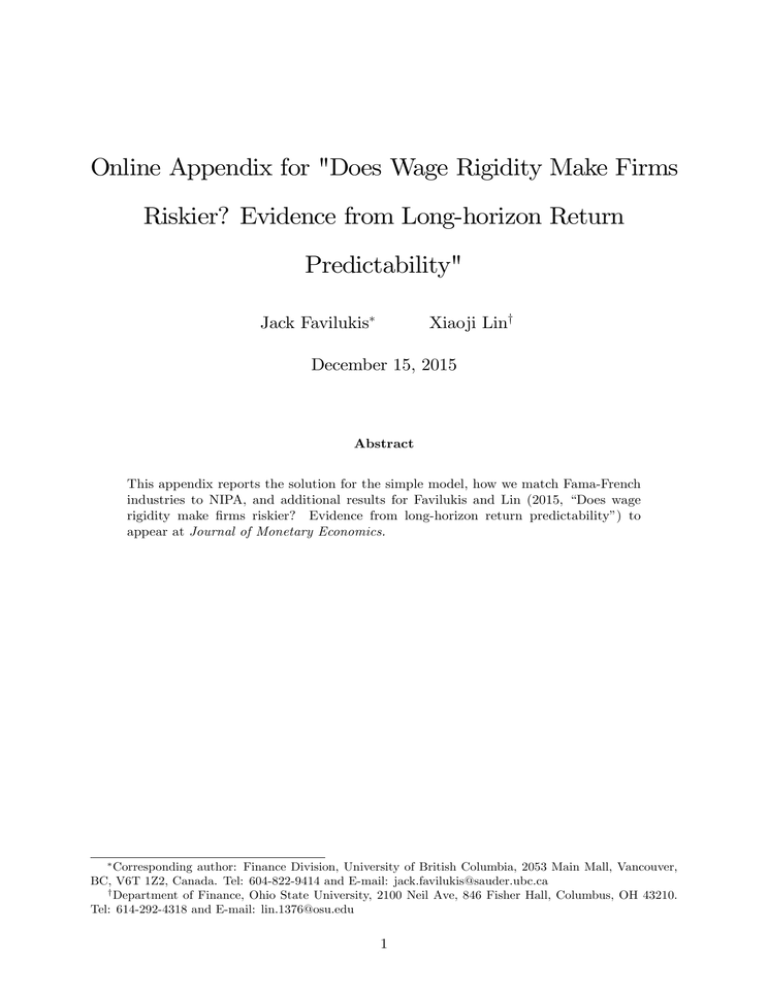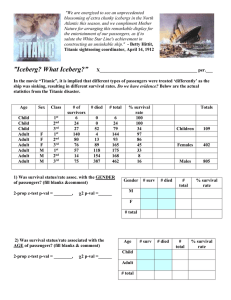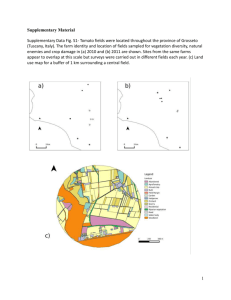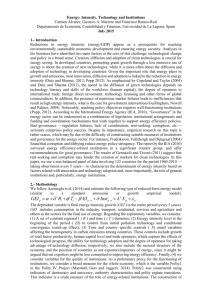Online Appendix for "Does Wage Rigidity Make Firms Predictability"
advertisement

Online Appendix for "Does Wage Rigidity Make Firms Riskier? Evidence from Long-horizon Return Predictability" Xiaoji Liny Jack Favilukis December 15, 2015 Abstract This appendix reports the solution for the simple model, how we match Fama-French industries to NIPA, and additional results for Favilukis and Lin (2015, “Does wage rigidity make …rms riskier? Evidence from long-horizon return predictability”) to appear at Journal of Monetary Economics. Corresponding author: Finance Division, University of British Columbia, 2053 Main Mall, Vancouver, BC, V6T 1Z2, Canada. Tel: 604-822-9414 and E-mail: jack.favilukis@sauder.ubc.ca y Department of Finance, Ohio State University, 2100 Neil Ave, 846 Fisher Hall, Columbus, OH 43210. Tel: 614-292-4318 and E-mail: lin.1376@osu.edu 1 1 Model The …rm’s value can be recursively written as: Vt = At ( Wt Wt = W t 1 1 + (1 + (1 ) At ) + Et [ At+1 At Vt+1 ] s:t: (1) ) At It is straight forward to guess, and verify that the …rm’s value function is linear in At and Wt 1 : Vt = VA At + VW Wt 1 . By plugging this into equation 1 and collecting coe¢ cients, we can show that: VW = VA = where b = E[ 1 At+1 At 1 1 1 b e 1 (1 ] and e = E[ ) + (1 At+1 At ]. (2) )VW e Because At is non-stationary (note that its growth rate At+1 At is stationary), it is useful to transform this into a stationary problem. De…ne vt = Vt =At and wt = Wt =At+1 , then vt = VA + VW wt 1 and wt+1 = At ( At+1 wt 1 + (1 ) ). To solve the extended model, we similarly rewrite it in terms of stationary variables. The original model is: Vt = Xt St + (1 Wt = W t 1 St )At + (1 Yt = Xt St + (1 ( Wt ) (1 + (1 1 ) (1 St )At ) + Et [ Yt+1 Yt Vt+1 ] s:t: (3) St )At St )At Detrending in exactly the same as before, the model is rewritten: v t = xt S t + 1 wt = At+1 At St ( wt 1 + (1 ) (1 St )) + Et [ At+1 At xt+1 St+1 +1 St+1 xt St +1 St vt+1 ] s:t: 1 ( wt 1 + (1 ) (1 St )) (4) We solve this model numerically by value function iteration. There are three state variables: At , At 1 xt , and St . We approximate At At 1 and xt by 3-state Markov processes, thus the grid size for each of these state variables is 3. The only continuous variable is St , which we approximate with a grid of size 13. 2 Matching Industries For industry returns we use the 49 Fama and French industries available from Ken French’s website. We need to collect corporate information such as wage growth and labor share for these industries. Industry data is available in NIPA Section 6. Wages are in Tables 6.6A (1929-1948), 6.6B (1948-1987), 6.6C (1987-2000), and 6.6D (2000-2011); data on compensation (Table 6.2), before tax pro…ts (Table 6.18), and capital consumption (Table 6.22) are analogous to wages. Although the aggregate data is available from 1929 to 2011, some of the industry classi…cations undergo changes in 1948, 1987, and 2000. We do our best to match NIPA industry names to names in the Fama and French data set. Because of a change in industry classi…cations, we collect industry data for 1929 to 2000 only. Although industry data is available post-2000, we were unable to reliably match enough industries between NIPA post-2000, NIPA pre-2000 and Ken French’s industry returns to make extending the data set to 2011 worthwhile. In the end we are left with 26 matched industries1 . 3 Additional Tables This section presents the results of the additional analysis in the paper. 1 We are also able to match Health Services, however returns data for this industry do not start until 1969. Furthermore, Rubber is missing returns for 1929-1930 and 1943-1944, for this industry we replace the missing values by BldMat which has the highest correlation (0.83) with Rubber. Similarly, Paper is missing values in 1929-1930 and 1935-1936, missing values are replaced with Chemical which has the highest correlation (0.82) with Paper. 2 3 W p-val R2 p-val p-val W p-val R2 p-val p-val W p-val R2 p-val p-val s W + W + W + W E[ W E[ W E[ ] ] ] -2.98 0.04 -10.53 0.63 10.82 0.64 0.08 -2.69 0.03 0.04 0.16 -0.04 0.16 0.08 -2.83 0.03 -0.09 0.56 0.15 0.56 0.07 1 -8.75 0.01 1.01 0.46 -0.58 0.46 0.19 -7.68 0.00 0.05 0.20 -0.05 0.19 0.22 -8.58 0.00 -0.73 0.60 0.66 0.60 0.19 2 -8.43 0.04 11.35 0.39 -11.03 0.39 0.12 -6.80 0.05 0.06 0.25 -0.06 0.25 0.18 -8.89 0.02 3.23 0.29 -3.29 0.29 0.14 3 5 6 = AC ( W ) t t -12.90 -17.57 -21.03 0.01 0.01 0.01 2.39 -1.11 2.32 0.35 0.59 0.40 -2.56 0.85 -2.52 0.35 0.58 0.40 0.20 0.23 0.24 t = 1=V OLt ( W ) -10.27 -15.01 -17.64 0.04 0.02 0.03 0.12 0.15 0.18 0.16 0.19 0.20 -0.12 -0.15 -0.18 0.16 0.19 0.20 0.21 0.25 0.28 t = DEMt -12.52 -17.46 -18.77 0.04 0.02 0.04 33.41 45.36 17.76 0.34 0.31 0.41 -33.26 -45.66 -19.21 0.34 0.31 0.41 0.16 0.21 0.24 4 -17.51 0.09 44.13 0.36 -46.35 0.36 0.22 -16.57 0.07 0.27 0.17 -0.26 0.17 0.23 -19.69 0.04 4.68 0.35 -4.71 0.35 0.16 7 -25.61 0.04 71.98 0.32 -74.59 0.31 0.29 -24.57 0.04 0.33 0.16 -0.33 0.15 0.28 -27.94 0.02 16.81 0.19 -16.51 0.19 0.23 8 -34.00 0.02 140.67 0.18 -143.06 0.17 0.33 -31.03 0.04 0.43 0.14 -0.43 0.14 0.31 -34.99 0.01 22.85 0.16 -22.46 0.16 0.26 9 -50.42 0.01 275.00 0.04 -275.99 0.03 0.43 -44.76 0.02 0.68 0.08 -0.66 0.08 0.44 -47.03 0.01 19.45 0.23 -19.26 0.23 0.33 10 -19.64 0.01 63.01 0.23 -63.89 0.22 0.23 -17.70 0.02 0.23 0.13 -0.23 0.13 0.25 -20.15 0.01 6.98 0.27 -6.96 0.26 0.20 Avg This table presents results from forecasting regressions of aggregate future stock returns at various horizons (denoted by s) on wage growth conditional on a rolling proxy for rigidity t . Speci…cally, the regression takes the form Rt;t+s = 0 + W + W t ) Wt + t;t+s . t +( t is either the 5-year backward looking autocorrelation of wage growth, the inverse of the 5-year backward looking volatility of wage growth, or the Democrat share of votes in the previous presidential election. We report the average dependence of returns on wage growth , and the cross-dependence W + W E[ ], the dependence on rigidity alone W . All p-values are obtained by a boot strapping procedure described in the text. Table A1: Aggregate Predictability with Rolling Measures of Rigidity 4 W p-val p-val p-val W p-val p-val p-val W p-val p-val p-val W p-val s W + W + W + W E[ W E[ W E[ ] ] ] -0.53 0.15 0.02 0.08 -0.02 0.08 0.24 0.70 1.39 0.10 -1.37 0.10 -2.06 0.01 0.04 0.03 -0.04 0.03 -0.41 0.20 2.09 0.16 -2.04 0.16 -0.68 0.16 15.70 0.16 -15.77 0.15 -1.16 0.09 0.36 0.70 0.49 0.88 -5.94 0.77 5.64 0.76 2 1 -3.36 0.01 0.05 0.07 -0.05 0.07 -1.34 0.04 1.82 0.29 -1.78 0.29 -1.70 0.03 42.51 0.02 -42.25 0.02 -2.60 0.03 3 5 6 Univariate -3.14 -4.33 -4.88 0.04 0.03 0.04 t = LSt -2.16 -2.94 -3.09 0.03 0.03 0.07 61.97 68.67 54.14 0.01 0.02 0.11 -61.34 -68.10 -54.11 0.01 0.02 0.11 t = ACt ( W ) -1.93 -2.39 -2.40 0.03 0.03 0.07 2.31 1.24 2.56 0.31 0.47 0.41 -2.32 -1.36 -2.70 0.31 0.46 0.40 t = 1=V OLt ( W ) -3.77 -4.77 -6.87 0.03 0.03 0.01 0.05 0.05 0.09 0.10 0.20 0.11 -0.05 -0.05 -0.09 0.10 0.19 0.11 4 -8.10 0.02 0.12 0.08 -0.12 0.07 -1.82 0.16 4.17 0.38 -4.39 0.36 -3.04 0.13 0.02 0.56 -1.54 0.56 -5.92 0.04 7 -11.71 0.01 0.17 0.05 -0.17 0.05 -4.70 0.03 4.37 0.43 -4.65 0.41 -6.31 0.02 36.45 0.33 -37.34 0.33 -10.24 0.01 8 -12.50 0.03 0.20 0.07 -0.20 0.07 -5.97 0.03 4.78 0.46 -5.07 0.45 -7.34 0.03 98.61 0.14 -99.11 0.14 -10.69 0.02 9 -13.34 0.04 0.17 0.18 -0.17 0.17 -7.49 0.02 4.04 0.55 -4.41 0.53 -9.07 0.03 66.54 0.28 -69.14 0.28 -13.18 0.02 10 -6.70 0.01 0.10 0.08 -0.10 0.08 -2.82 0.03 2.88 0.41 -3.01 0.41 -3.59 0.03 43.87 0.15 -44.31 0.16 -5.58 0.01 Avg This table presents Fama-MacBeth regressions to test return predictability for industries. In particular, in every period t we regress future realized returns Rt+1;t+s (realized at t + 1 and i i i i after) on industry characteristics known at time t: Rt;t+s = 0;t + ;t it + ( W;t + W;t t ) Wt + t;t+s . This produces coe¢ cients for every year of the data set and we report the average of these. it indicates the speci…c industry characteristic, it is either labor share or one of two proxies of wage rigidity. The proxies are the 5-year backward looking autocorrelation of wage growth, or the inverse of the 5-year backward looking volatility of wage growth. All p-values are obtained by a boot strapping procedure described in the text. Table A2: Fama-MacBeth with Rolling Measures of Rigidity: Industry 5 W p-val p-val p-val W p-val p-val p-val W p-val p-val p-val W p-val p-val p-val W p-val s W + W + W + W + W E[ W E[ W E[ W E[ ] ] ] ] -0.22 0.18 -5.26 0.92 5.12 0.92 -0.13 0.26 0.03 0.09 -0.03 0.10 -0.12 0.28 -0.55 0.73 0.55 0..73 -0.55 0.11 -7.46 0.84 7.35 0.84 -0.66 0.07 -0.03 0.66 0.03 0.66 -0.58 0.09 3.41 0.10 -3.32 0.10 -0.64 0.10 -5.65 0.73 5.78 0.74 -0.80 0.05 -0.23 0.16 -0.21 0.20 -5.57 0.85 5.51 0.86 2 1 -1.05 0.04 -4.63 0.59 4.79 0.60 -1.24 0.02 -0.06 0.69 0.06 0.70 -0.99 0.06 5.22 0.07 -5.09 0.06 -1.35 0.04 3.41 0.41 -3.10 0.41 -1.35 0.02 3 5 6 Univariate -2.81 -3.41 -3.11 0.00 0.00 0.00 t = LSt -2.84 -3.66 -3.35 0.00 0.00 0.00 -3.47 3.92 4.42 0.64 0.49 0.49 3.61 -3.65 -3.99 0.64 0.48 0.49 t = ACt ( W ) -2.55 -3.45 -3.19 0.00 0.00 0.00 4.40 2.99 2.76 0.20 0.41 0.47 -4.27 -2.81 -2.49 0.20 0.41 0.48 t = 1=V OLt ( W ) -2.73 -3.54 -3.08 0.00 0.00 0.00 -0.01 0.03 -0.03 0.37 0.18 0.34 0.01 -0.03 0.02 0.37 0.17 0.34 t = DEMt -2.50 -3.20 -2.98 0.00 0.00 0.00 2.81 14.01 24.27 0.29 0.10 0.04 -2.41 -13.18 -23.12 0.29 0.10 0.04 4 -1.93 0.03 37.23 0.01 -35.35 0.01 -1.65 0.05 -0.14 0.69 0.14 0.70 -1.97 0.04 5.24 0.34 -4.84 0.35 -2.35 0.03 9.27 0.41 -8.43 0.42 -2.15 0.03 7 -1.28 0.11 36.83 0.03 -34.63 0.03 -0.69 0.14 -0.18 0.70 0.17 0.69 -1.54 0.07 5.49 0.40 -4.99 0.41 -1.50 0.12 9.14 0.44 -8.14 0.44 -1.50 0.09 8 -0.47 0.20 30.50 0.07 -28.06 0.08 0.27 0.28 -0.26 0.81 0.25 0.81 -0.78 0.14 8.25 0.30 -7.66 0.31 -0.48 0.27 8.41 0.45 -7.28 0.46 -0.83 0.16 9 -0.85 0.14 24.63 0.13 -22.28 0.14 0.33 0.28 -0.22 0.66 0.21 0.66 -1.01 0.14 17.45 0.08 -16.73 0.09 -0.71 0.26 11.77 0.41 -10.70 0.41 -1.03 0.15 10 -1.50 0.01 15.29 0.08 -14.18 0.08 -1.31 0.03 -0.09 0.60 0.08 0.60 -1.62 0.02 5.47 0.23 -5.17 0.24 -1.71 0.02 3.56 0.49 -3.04 0.48 -1.72 0.02 Avg This table presents Fama-MacBeth regressions to test return predictability for states. In particular, in every period t we regress future realized returns Rt+1;t+s (realized at t + 1 and after) i i i i on state characteristics known at time t: Rt;t+s = 0;t + ;t it + ( W;t + W;t t ) Wt + t;t+s . This produces coe¢ cients for every year of the data set and we report the average of these. it indicates the speci…c state characteristic, it is either labor share or one of three proxies of wage rigidity. The proxies are the 5-year backward looking autocorrelation of wage growth, the inverse of the 5-year backward looking volatility of wage growth, or the Democrat share of total votes. All p-values are obtained by a boot strapping procedure described in the text. Table A3: Fama-MacBeth with Rolling Measures of Rigidity: State 6 Transportation Communication Electric, gas, and sanitary services Wholesale trade Retail trade and automobile services Security and commodity brokers, and services Insurance carriers Real estate Hotels and other lodging places Personal services 60 62 63 58 52 53 56 61 62 58 56 50 51 55 38 46 49 31 32 33 35 38 46 49 31 32 33 35 Hotels and other lodging places Personal services Real estate Motor vehicles and equipment Food and kindred products Tobacco manufactures Textile mill products Apparel and other textile products Paper and allied products Printing and publishing Chemicals and allied products Rubber and miscellaneous plastics products Transportation Communication Electric, gas, and sanitary services Wholesale trade Retail trade Security and commodity brokers Insurance carriers 61 62 58 56 50 51 55 38 46 49 31 32 33 35 22 27 28 29 30 22 27 28 29 30 Motor vehicles and equipment Food and kindred products Tobacco manufactures Textile mill products Apparel and other textile products Paper and allied products Printing and publishing Chemicals and allied products Rubber products 23 27 28 29 30 Hotels and other lodging places Personal services Real estate Industrial machinery and equipment Motor vehicles and equipment Food and kindred products Tobacco products Textile mill products Apparel and other textile products Paper and allied products Printing and publishing Chemicals and allied products Rubber and miscellaneous plastics products Transportation Communications Electric, gas, and sanitary services Wholesale trade Retail trade Security and commodity brokers Insurance carriers 20 20 Machinery, except electrical 6C number and name 4 Agriculture, forestry, and …sheries 8 Metal mining 9 Coal mining 10 Oil and gas extraction 12 Construction 18 Primary metal industries 6B number and name 4 Agriculture, forestry, and …sheries 8 Metal mining 9 Coal mining 10 Oil and gas extraction 12 Construction 18 Primary metal industries 6A number and name 4 Agriculture, forestry, and …sheries 8 Metal mining 9 Anthracite mining 11 Crude petroleum and natural gas 13 Contract construction 19 Iron and steel and their products, including ordnance 21 Machinery, except electrical Goods Goods Goods Goods Transportation Communications Electric, gas, and sanitary services Wholesale trade Retail trade Finance, Insurance, and Real Estate Finance, Insurance, and Real Estate Finance, Insurance, and Real Estate Services Services Nondurable Nondurable Nondurable Nondurable Durable Goods Nondurable Goods Nondurable Goods Nondurable Goods Nondurable Goods Durable Goods 6 coarse name Agriculture, forestry, and …sheries Mining Mining Mining Construction Durable Goods 44 33 47 46 42 43 48 41 32 31 39 8 14 15 23 2 5 16 10 21 28 29 30 18 19 Meals PerSv RlEst Insur Whlsl Rtail Fin Trans Telcm Util Paper Books Chems Rubbr Autos Food Smoke Txtls Clths Mach Mines Coal Oil Cnstr Steel FF number and name 1 Agric In this table we present the industry name and number from NIPA tables 6.XA, 6.XB, 6.XC and the matched industry in the Fama and French 49 industry data set. Here X is 6 for wages, 2 for compensation, 18 for before tax pro…ts, and 22 for capital consumption. Table A4: Matching industries







